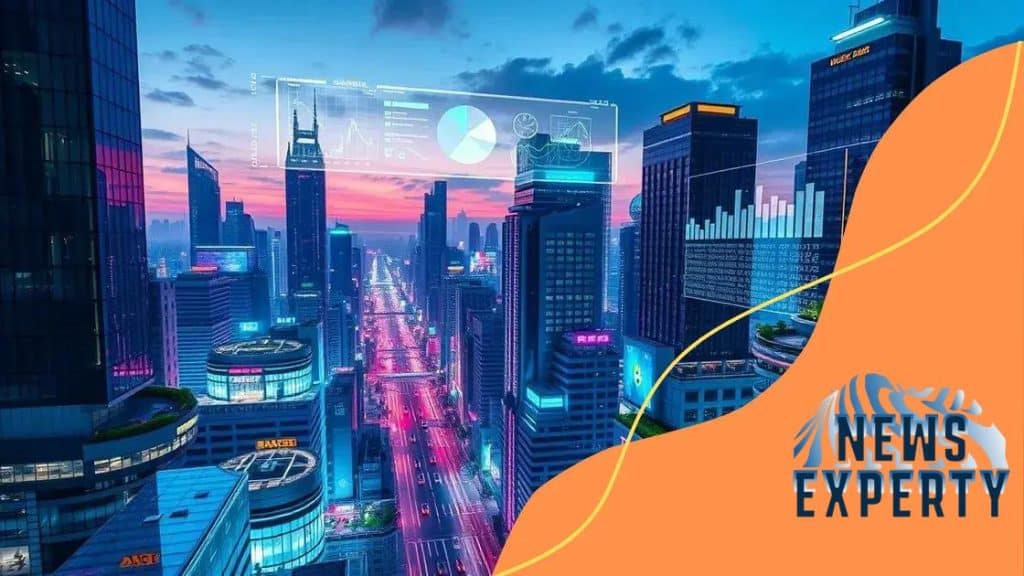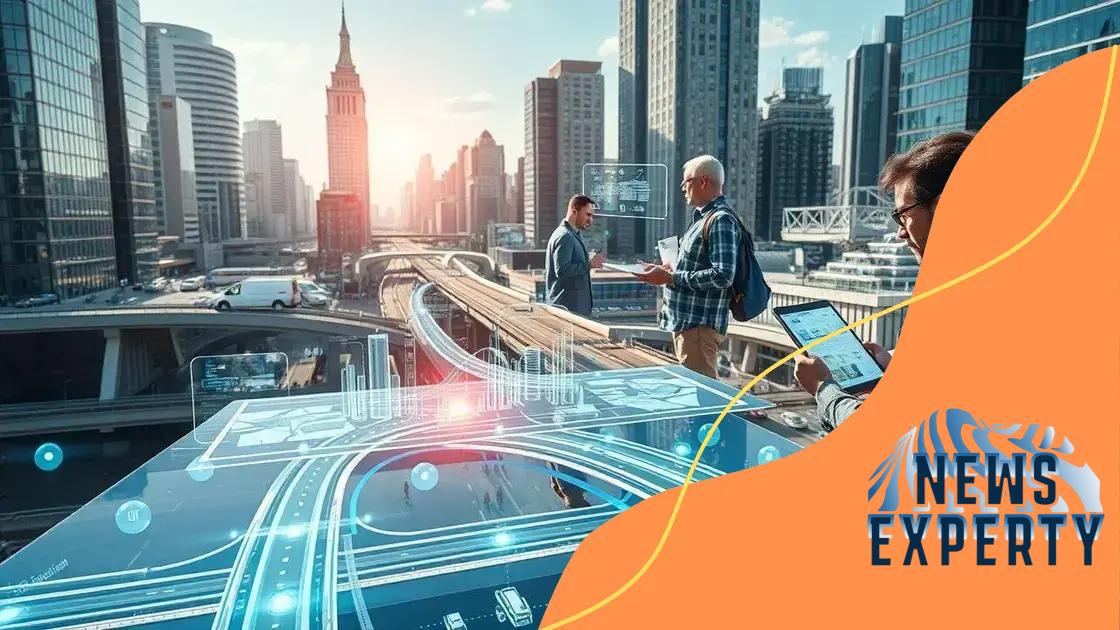How digital twins are revolutionizing urban planning

Anúncios
Digital twins are revolutionary tools in urban planning that create virtual representations of city elements, enabling smarter design decisions, enhanced sustainability, and improved community engagement by utilizing real-time data and simulations.
How digital twins are revolutionizing urban planning is a question many urban planners are asking today. This innovative technology holds significant potential for creating more efficient and sustainable cities. What does this mean for our urban spaces? Let’s explore.
Anúncios
Understanding digital twins in urban planning
In today’s urban landscape, understanding digital twins is crucial for effective city planning. These digital replicas of physical environments allow planners to simulate various scenarios and enhance decision-making. By leveraging data, cities can build smarter infrastructure while reducing costs and improving quality of life.
What are Digital Twins?
A digital twin is an advanced model that mirrors a physical asset, process, or system. This technology integrates data from sensors, models, and real-time input to create a dynamic representation. When applied to urban planning, digital twins encompass various city elements, from buildings to transportation systems. They can predict outcomes of design choices and urban policies.
- Enhanced data analysis for informed decision-making
- Real-time monitoring of urban environments
- Improved collaboration among stakeholders
- Predictive modeling for future developments
Digital twins facilitate collaboration between city officials, architects, and engineers. By visualizing potential changes, stakeholders can better understand the impact of their decisions. This technology helps minimize errors and enhances project efficiency. As cities grow, the complexity of planning processes increases. Thus, using digital twins streamlines workflows and provides clarity.
Anúncios
Benefits of Digital Twins in Urban Planning
The advantages of utilizing digital twins in urban planning are numerous. They improve resource allocation by identifying which areas need attention. Cities can respond swiftly to challenges, such as traffic congestion or infrastructure wear. Furthermore, digital twins support sustainable development by assessing the environmental impact of urban changes.
- Real-time data integration and analysis
- Enhanced visualization of complex urban systems
- Effective risk management for urban projects
- Promotion of sustainable practices in development
As urban planners continue to adopt digital twin technology, they pave the way for more resilient cities. The future will see an increased reliance on these technologies to address the ever-growing demands of urbanization. Digital twins are not just a trend; they are a transformative tool that shapes the urban environments of tomorrow.
Key benefits of digital twins for cities
Exploring the key benefits of digital twins for cities reveals how this technology can reshape urban environments. By creating accurate virtual models, cities can analyze and improve their infrastructures, services, and citizen engagement.
Enhanced Decision-Making
Digital twins support data-driven decisions by providing real-time insights and analytics. City planners can visualize the impacts of their choices, leading to more effective strategies. This allows for swift adjustments to urban policies and improves the overall planning process.
- Real-time data integration for analysis
- Simulation of various planning scenarios
- Automatic updates based on new information
- Predictive insights that guide future developments
Additionally, digital twins encourage collaboration among various stakeholders, including government officials, residents, and businesses. By sharing a common platform, these parties can engage in discussions that lead to more sustainable urban practices. This transparency fosters trust and can enhance the quality of life in cities.
Resource Management
Effective resource management is another significant advantage of using digital twins. With the ability to simulate and forecast resource needs, cities can allocate funds more efficiently. They can also identify areas needing urgent attention, thereby optimizing service delivery.
- Improved monitoring of infrastructure health
- Efficient energy usage strategies
- Minimized waste through better planning
- Enhanced public safety preparedness
The environmental benefits of employing digital twins cannot be overlooked. As cities face growing concerns about climate change, these models can help assess the effects of proposed projects on the community and the environment. By adopting a more sustainable approach to urban planning, cities become more resilient and adaptable.
Real-world applications of digital twins

Exploring the real-world applications of digital twins highlights how this innovative technology is being utilized in various sectors. These applications show the versatility of digital twins and their potential to revolutionize how we interact with urban environments.
Urban Planning and Development
In urban planning, digital twins serve as virtual models that help visualize city projects. Planners use them to assess the effects of new buildings and infrastructure. This technology enables simulations of traffic flow, pedestrian safety, and environmental impacts, thereby supporting better decision-making.
- Visualization of proposed urban designs
- Traffic simulation and optimization
- Environment impact assessments for projects
- Community engagement through immersive presentations
Moreover, cities can monitor changes over time, ensuring that developments align with sustainable practices. By adopting digital twins, urban planners can significantly reduce costs and improve outcomes for residents.
Infrastructure Management
Another prominent application is in infrastructure management. Digital twins help maintain and optimize systems like water supply and transportation networks. By continuously monitoring conditions, they identify issues before they become critical.
- Real-time monitoring of infrastructure health
- Predictive maintenance scheduling
- Efficient energy management in city utilities
- Enhanced safety protocols
These advances lead to reduced operational costs and improved service reliability for citizens. Cities can also respond more effectively to emergencies by simulating various scenarios, making them better prepared for unexpected events.
Smart Cities and IoT Integration
Digital twins are integral to the development of smart cities. By integrating Internet of Things (IoT) devices with digital twins, cities can gather vast amounts of data. This data helps improve public services, such as waste management and public transportation.
- Optimizing waste collection routes
- Enhancing public transport scheduling
- Improving energy distribution efficiency
- Creating responsive public services based on real-time data
This integration fosters a more connected urban environment, allowing for proactive adjustments that enhance the quality of life for residents. The use of digital twins in these applications continues to grow, demonstrating their importance in shaping the future of cities.
Challenges in implementing digital twins
Addressing the challenges in implementing digital twins is essential for successful integration into urban planning. While this technology offers significant benefits, various obstacles can hinder its adoption.
Data Management Issues
One main challenge involves managing the vast amounts of data generated by digital twins. Ensuring data quality, accuracy, and consistency is crucial. Poor data can lead to inaccurate models and ineffective decision-making. Additionally, integrating data from multiple sources can be complex and time-consuming.
- Ensuring data accuracy and consistency
- Handling large volumes of real-time data
- Integrating disparate data sources
- Establishing effective data governance
Moreover, cities must invest in proper infrastructure to store and analyze the data effectively. Without a robust system in place, the benefits of digital twins can be severely limited.
Technological Barriers
Technological barriers also present significant challenges. Many cities may not have the necessary technology or expertise to create and maintain digital twins. This can lead to reliance on external consultants, which can be costly.
- Lack of skilled personnel in data science
- Outdated technology infrastructure
- Complexity of developing accurate simulations
- High initial costs of implementation
Often, organizations face difficulties in aligning their existing systems with new digital twin technologies. This integration process requires thorough planning and execution to avoid disruptions.
Stakeholder Engagement
Engaging stakeholders can also be a challenge, as various parties may have differing interests and priorities. Gaining buy-in from all relevant stakeholders, including government officials, businesses, and the community, is essential for successful implementation.
- Addressing differing priorities among stakeholders
- Fostering collaboration and communication
- Educating the community about digital twin benefits
- Managing expectations regarding outcomes
These challenges underscore the need for a clear strategy that involves all stakeholders from the outset. Adequate training and communication can help alleviate concerns and encourage support for the initiative.
The future of urban planning with digital twins
The future of urban planning is bright with the integration of digital twins. This technology is set to transform how cities are designed, built, and maintained. As urbanization continues to escalate, digital twins offer innovative solutions to complex urban problems.
Advancements in Technology
Technological advancements will significantly shape the future of digital twins. As data collection methods improve, cities will gain access to more accurate and real-time information. This wealth of data allows urban planners to create more precise models that reflect current conditions and predict future scenarios.
- Increased use of IoT devices for real-time data
- Improved data analytics tools for better decision-making
- Integration of artificial intelligence to enhance simulations
- Greater accessibility of high-quality imaging technologies
With these tools, planners will be able to explore various options and consequences, leading to better-informed choices in urban development.
Sustainability and Resilience
As cities strive for sustainability, digital twins will play a crucial role in creating resilient urban environments. By analyzing the impact of new developments, planners can ensure that growth is sustainable and environmentally friendly. Digital twins help assess resource usage and environmental impacts, leading to greener choices.
- Reducing carbon footprints through efficient designs
- Assessing environmental impacts before project implementation
- Creating adaptive urban spaces that respond to climate change
- Promoting community engagement in sustainability initiatives
This focus on sustainability will not only benefit the environment but will also enhance the quality of life for residents.
Enhanced Collaboration
The adoption of digital twins facilitates better collaboration among stakeholders. With shared access to models, city officials, architects, engineers, and the community can work together more effectively. This collaboration fosters transparency and trust, ensuring that all voices are heard during the planning process.
- Engaging the community in urban design
- Streamlining communication among various departments
- Encouraging public-private partnerships
- Fostering innovation through collaborative problem-solving
As we look ahead, the influence of digital twins in urban planning cannot be underestimated. This technology promises to create smarter, more adaptive cities that cater to the needs of all their citizens.
FAQ – Frequently Asked Questions about Digital Twins in Urban Planning
What are digital twins?
Digital twins are virtual replicas of physical assets, processes, or systems that help simulate and analyze real-world scenarios.
How do digital twins improve urban planning?
They allow urban planners to visualize designs, predict outcomes, and make data-driven decisions, enhancing the overall planning process.
What challenges are associated with implementing digital twins?
Challenges include data management issues, technological barriers, and the need for stakeholder engagement and collaboration.
What is the future of urban planning with digital twins?
The future includes smarter, more resilient cities that utilize real-time data to enhance sustainability and community collaboration.





